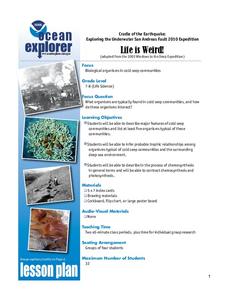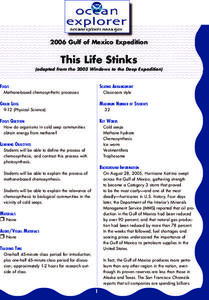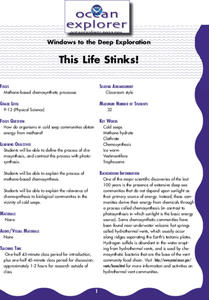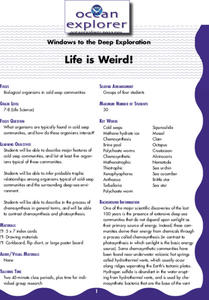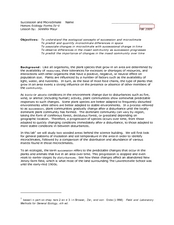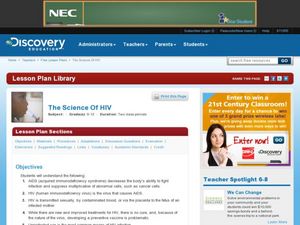Curated OER
Save a Reef!
Design a public information campaign to improve understanding of the coral reef crisis. Read about and discuss the biology and threats to the coral reef. The class creates a public information program about the problems facing the coral...
Curated OER
Ecosystem Interactions in Refuges
Seventh graders, using national parks as models, illustrate the energy flow in ecosystems. Working in groups, they use murals, flow charts, or other visual displays to record their findings. Students represent the food chains and webs...
Curated OER
This Life Stinks
Students study cold seeps and see how organisms obtain energy from methane. In this sinkholes lesson students examine the relevance of chemosynthesis to communities.
Curated OER
Preparing for the Possibility of Terrorists
Students investigate what schools and communities can do to be prepared for terrorist attacks, review school's disaster plan, research types of possible attacks, prepare infographic that makes facts clear, and write news article...
Curated OER
Investigative Case - "Malama Keone'o'io"
Students study techniques for conducting a local environmental assessment in an ecologically sensitive area. Identification of native plants and methodologies for sampling is taught in the classroom and then reinforced in the field. The...
Teach Engineering
Computer Simulation of the Sonoran Desert Community
See how changes in initial populations and parameters affect a biological community. Individuals use a special software program to simulate a desert community with five species. They adjust initial populations to see how the community...
Curated OER
Life is Weird
Students describe features of cold seep communities and investigate five organisms that live there. In this biological organisms lesson students research a given species and give an oral presentation on their results.
Curated OER
Life is Weird
Students describe features of cold seep communities and list organisms that can be found in these communities. In this exploratory lesson students complete an activity and describe the process of chemosynthesis.
Curated OER
This Life Stinks
Chemosynthetic communities of cold seep areas are considered in this lesson. Working in collaborative groups, marine biology or oceanography learners research and prepare a report about oxidation-reduction reactions involved with...
Curated OER
Using A Winogradsky Column to Analyze Microbial Communities
Students use easily obtained materials to study ecological succession in a microbiological community. They collect water samples from outdoor sources in plastic bottles to observe and record changes.
Curated OER
History's Thermometers
Ancient coral beds give scientists clues to past ocean temperatures in much the same way that tree rings indicate historical weather conditions. High school scientists examine coral oxygen isotope ratios and plot the data as a function...
Curated OER
Introduction to Watsonville Wetlands
Identify the different plants and animals found in wetlands, your class will explain the importance of wetland ecosystem and locate the different wetlands in their area.
Curated OER
How Does Your (Coral) Garden Grow?
Analyze and graph oxygen isotope ratios in coral samples in relation to the distance from the outer skeleton edge. Compare the data to the mean monthly water temperatures. Uncover whether or not there is any correlation. In addition to...
Curated OER
What's That?
Meant to be a simulation of a deep-sea exploration, this requires that another lesson be completed first. In that lesson, titled "Animals of the Lost City," marine biology buffs construct murals of benthic communities. In this lesson,...
Curated OER
Ring Detectives
Learners describe the overall flow of the Gulf Stream, and explain how it affects biological communities in the North Atlantic Ocean.Students describe Gulf Stream rings, and explain how they are formed.Learners be abl
Curated OER
This Life Stinks!
Young scholars explore the process of chemosynthesis and contrast this process with photosynthesis. They consider the relevance of chemosynthesis to biological communities in the vicinity of cold seeps.
Curated OER
How do living and non-living structures affect coral reef habitats?
Students create model coral reefs showing surface area and including examples of communities. In this coral reef activity, students research and explore the functions or benefits from a coral reef. Students design a benthic habitat....
Curated OER
Field Biology
Students work with 4th and 5th graders at Cascade Brook School in Farmington, to teach them skills in wildflower and fern identification, and then to help them implement a nature trail, which is accessible to the greater Farmington...
Biology Junction
Ecology
Psychologists study human relationships while ecologist study relationships between organisms in the environment. An introduction to ecology and the related vocabulary benefits scholars as they progress through the presentation and...
Curated OER
Life is Weird!
Students describe major features of cold seep communities, and list at least five organisms typical of these communities. They infer probable trophic relationships among organisms typical of cold-seep communities and the surrounding...
Curated OER
Amphipods
Students identify organisms that live at the bottom of the body of water. In this biology lesson, students evaluate the effects of pollution to amphipods population. They examine collected data and create a bar graph comparing them.
Curated OER
Succession and Microclimate
Students compare the population of insects in different microclimates. In this biology activity, students collect data using probes to tabulate temperature and soil data. They predict how certain parameters change as an area goes through...
Curated OER
The Science of HIV
High schoolers research about the characteristics of HIV. In this biology lesson, students cite ways to prevent AIDS especially among uninformed teens. They plan a community awareness campaign targeting teens.
Curated OER
Terrariums for Project Pals
Students identify the components needed by plants to survive in the terrarium. In this biology lesson, students build their own terrariums using materials available. They present their project in class.








